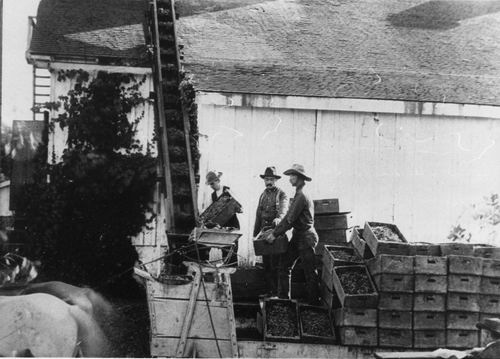Thrice Sorted: The story behind Livermore’s most famous wine

Occasio is the story of time and opportunity as expressed through our wines. Because we choose to remain small, we can afford the time we need to think things through, and the opportunity to put these thoughts into action. Time and opportunity – resources that are often too costly for larger wineries, yet necessary to express the beauty of our valley’s most historic wines.
Our sauvignon blanc, harvested last week, is a good example of the thought process that goes into the crafting of an Occasio wine. We harvested the fruit with a singular goal – to produce a sauvignon blanc reminiscent of our valley’s most historic wine. We use as our model the sauvignon blanc produced by Charles Wetmore at Cresta Blanca, arguably one of the finest wines ever crafted. In 1889, Cresta Blanca Sauvignon Blanc bested wines from all of the first growths in France as well as the finest wines in all of the world when it received the grand prize at the Paris Exposition. So famous was this wine that other winemakers in our valley soon adopted the Cresta Blanca style, and even the owner of Chateau D’Yquem, Marquis Bernard de Lur-Saluces, came to Livermore in 1939 to learn how this wine was made. The Cresta Blanca style defined Livermore sauvignon blanc for nearly a century.
The story of Livermore’s most famous wine began with a letter of introduction from Livermore vineyard owner Marie Mel to Charles Wetmore. Armed with this letter, Wetmore traveled to France, where he now had access to its finest vineyards. At Chateau d’Yquem, then, as now, famous for sauvignon blanc, he selected the cuttings he would plant on return. His goal was to produce a sauvignon blanc the equal of any in Europe.
The story continues in late summer of 1887, as workers began the task of hand harvesting the fruit from the Cresta Blanca vineyard. They placed the fruit into small wood boxes and took them by horse-drawn cart to the nearby winery. Here, the grapes were sorted a second time, and placed on an elevator that transported them to an upper floor where they fell onto a metal mesh. The grape clusters were carefully raked over the mesh, separating the berries from the stems. The freed berries fell through the mesh and through an opposing pair of cylindrical rollers that gently crushed the berries. The freed juice (we call it free run today) was separated from the berries and fermented by itself. The crushed berries were sent to a press, where any remaining juice was squeezed out. This press fraction was fermented separately so that, in the end, Wetmore had the option of blending back a fraction of the press wine according to his taste.
Wetmore, by his careful actions, was attempting to control skin contact with his sauvignon blanc. He knew that while the skins contained important varietal flavors, they also had undeveloped tannins that, if extracted into the wine, would produce a bitterness that would never go away. Thus, by separating the free run juice, he avoided extraction of the skin tannins, while leaving the option open to blend back some of the skin components at a later time.
Wetmore was careful to record the separation distance between the rollers, giving just enough pressure to expel the interior pulp, which contains the acids, sugars, and flavor precursors, while avoiding the expression of the peripheral cells that contain the bitter tannin molecules. In essence, Wetmore was thrice-sorting his wine: first in the vineyard, then again before the stemmer, and finally at the crush, where he sorted the juice according to the chemistry of taste.
At Occasio, we carry on the tradition of thrice-sorting in all our white wines. But today, we do it with greater control and with less damage to the wine. We sort at the vineyard, and once again before the press. But we no longer destem the clusters. Instead, we press them as whole clusters in our membrane press. Here, we can precisely control the pressure and the time, so that we can selectively express the portions of the berry that provide us the varietal flavors without the bitterness. Through our proprietary pressing cycle,* we obtain the third sort before we ferment the wine.
Thrice – sorting takes time and resources that large wineries cannot afford. But this is Occasio, where we have both time and opportunity to do things right.
*Our proprietary press cycle is based upon several years of published research on the mechanical properties of grapes. From these studies, it is possible to calculate the pressure required to express the different cells within the berry.


